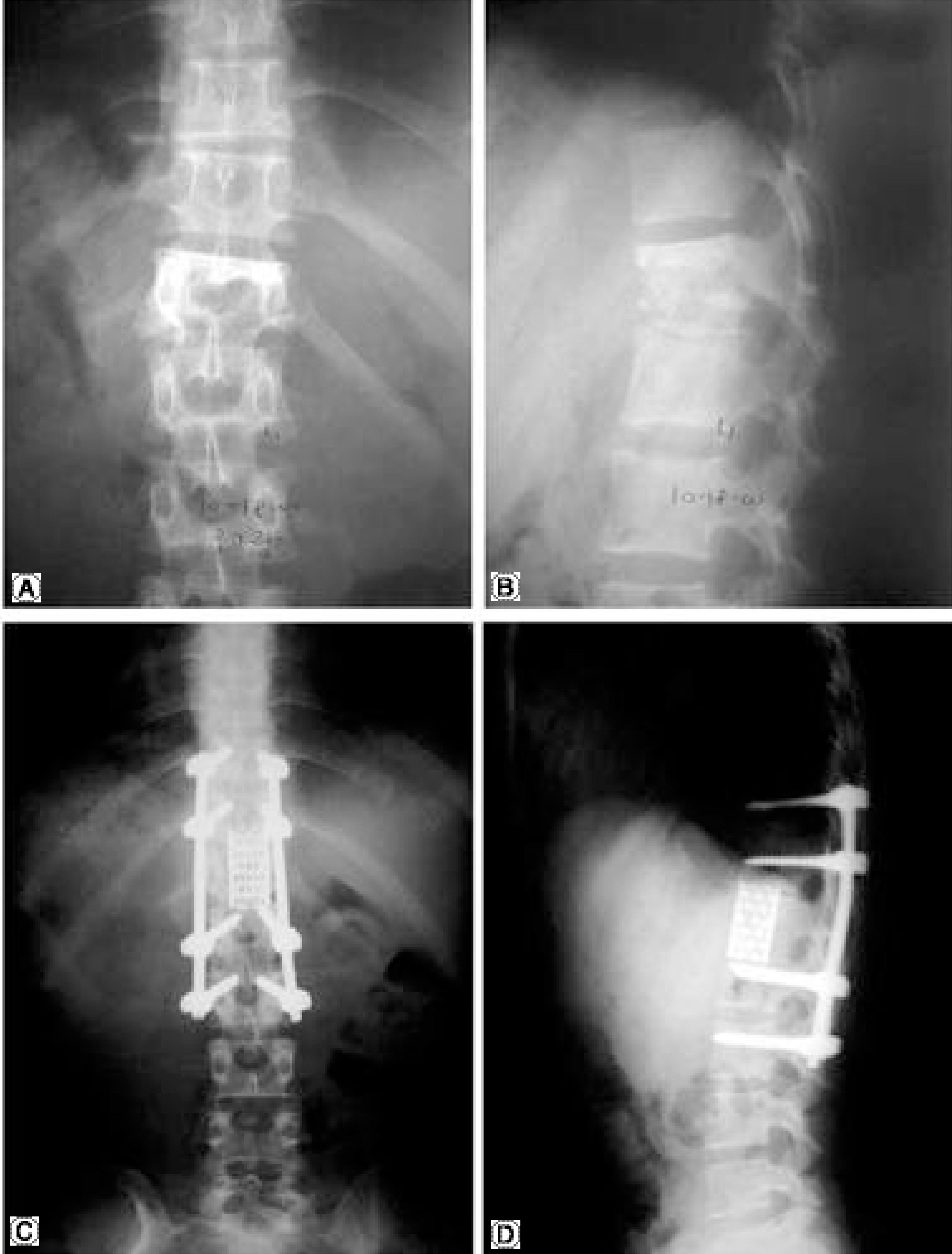J Korean Soc Spine Surg.
2003 Jun;10(2):163-171. 10.4184/jkss.2003.10.2.163.
Safety and Efficacy of Metalic Implants in the Treatments of Tuberculous Spondylitis
- Affiliations
-
- 1Department of Orthopaedic Surgery, Soonchunhyang University College of Medicine, Bucheon, Korea. schsbj@schbc.ac.kr
- 2Department of Orthopaedic Surgery, Hallym University College of Medicine.
- KMID: 2003214
- DOI: http://doi.org/10.4184/jkss.2003.10.2.163
Abstract
- STUDY DESIGN: A retrospective study
OBJECTIVE
To analyze the safety and effectiveness of treatments using metallic implants in the tuberculous spondylitis. SUMMARY OF LITERATURE REVIEW: Residual kyphosis and loss of correction remain the major problems following surgery for tuberculous spondylitis. Several authors have used metallic implants for the prevention of these complications. However, the safety of metallic implants use in tuberculous spine infections are still controversial.
MATERIALS AND METHODS
Seventeen patients, who underwent surgery, and were stabilized by the use of a metallic implant for tuberculous spondylitis, and followed up for more than 1 year were included in this study. All patients were treated with combined anterior fusion (with or without mesh) and/or posterior pedicle screw instrumentation. The patients were followed up with serial plain radiographs, laboratory inflammatory parameters and neurological recovery.
RESULTS
The overall correction of the kyphotic deformity was initially 8.5 degrees, and loss of correction occurred at 5.8 degrees. Although some loss of correction occurred, even after the use of a metallic implant, clinically significant kyphotic deformity was effectively prevented. There were no cases of persistent infection or failure to control infection when the metallic implantation was combined with an anterior radical debridement and chemotherapy. The erythrocyte sedimentation rate and C-reactive protein were eventually normalized in all patients. The preoperative neurological deficits were: incomplete paralysis in 9 cases and radiculopathy in 4. At the final follow-up, 11 cases had completely recovered, partial residual neurological deficits remaining in 2.
CONCLUSIONS
The use of instrumentation with metallic implants, in tubercuous spondylitis of the spine, provided immediate stability, and did not prohibit the control of infection when combined with radical debridement and anti-tuberculous chemotherapy.
Keyword
MeSH Terms
Figure
Reference
-
1). Bailey HL., Gabriel M., Hodgson AR., Shin JS. Tuberculosis of the spine in children: Operative findings results in one hundred consecutive patients treated by removal of the lesion and anterior grafting. J Bone Joint Surg. 54-A:1633–1657. 1972.2). Chen WJ., Chen CH., Shih CH. Surgical treatment of tuberculous spondylitis. Acta Orthop Scand,. 66(2):137–142. 1995.3). Chen WJ., Wu CC., Jung CH., Chen LH., Niu CC., Lai PL. Combined anterior and posterior surgeries in the treatment of spinal tuberculous spondylitis. Clin Orthop,. 398:50–59. 2002.
Article4). Guven O., Kumano K., Yalcin S., Karahan M., Tsuji S. A single stage posterior approach and rigid fixation for preventing kyphosis in the treatment of spinal tuberculo -sis. Spine,. 19:1039–1043. 1994.5). Hodgson AR., Stock FE. Anterior spine fusion for the treatment of tuberculosis of the spine. J Bone Joint Surg,. 42-A:295–310. 1960.
Article6). Kemp HBS., Jackson JW., Jeremiah JD., Cook J. Anterior fusion of the spine for infective lesions in adults. J Bone Joint Surg,. 55-B:715–734. 1973.
Article7). Kim KS., Ko SH., Youm KS., Choi CH., Yang JH. Anterior spinal instrumentation in treatment of spinal tuberculosis. J Kor Orthop Assoc,. 33:1560–1568. 1998.
Article8). Kim BJ., Ko HS., Lim Y., Seo JK., Choi JY., Suh JS. Surgical treatment of paraplegia in spinal tuberculosis. J Kor Orthop Assoc,. 28:1595–1602. 1993.
Article9). Kim BJ., Ko HS., Lim Y., Seo JG., Zoo SK., Jeon TH. The clinical study of the tuberculous spondylitis. J Kor Orthop Assoc,. 28:2221–2232. 1993.
Article10). Lee EY., Hahn MS. A study of influences of the qnte -rior intervertebral fusion upon the correctability of kypho -sis in tuberculous spondylitiss. J Kor Orthop Assoc,. 3:31–40. 1968.11). Medical Research Council Working Party on Tuberculosis of the Spine. A 5-year assessment of controlled trials of in-patients & out-patients treatment & of plaster of Paris jacket for tuberculosis of the spine in children on standard chemotheraphy: Studies in Masan & Pusan, Korea. J Bone Joint Surg. 58-B:399–414. 1976.12). Moon MS., Woo YK., Lee KS., Ha KY., Kim SS., Sun DH. Posterior instrumentation and anterior interbody fusion for tuberculous kyphosis of dorsal and lumbar spines. Spine,. 20:1910–1916. 1995.
Article13). Moon MS., Woo YK., Ok IY., Lee KS., Kang YK., Ha KY., Kim SS. Posterior instrumentation for treatment of active dorsolumbar tuberculosis with kyphosis. J Kor Orthop Assoc,. 24:660–665. 1989.
Article14). Oga M., Arizono T., Takasita M., Sugioka Y. Evaluation of the risk of instrumentation as a foreign body in spinal tuberculosis. Spine,. 18:1890–1894. 1993.
Article15). Rajasekaran S., Shanmugasundaram TK. Prediction of the angle of Gibbus deformity in tuberculosis of the spine. J Bone Joint Surg,. 69-A:503–509. 1987.
Article16). Rajasekaran S., Soundarapandian S. Progression of kyphosis in tuberculosis of the spine treated by anterior arthrodesis. J Bone Joint Surg,. 71-A:1314–1323. 1989.
Article17). Rezai AR., Lee M., Cooper PR., Errico TJ., Koslow M. Modern management of spinal tuberculosis. Neuro -surg,. 36:87–98. 1995.
Article18). Safran O., Rand N., Kaplan L., Sagiv S., Floman Y. Sequential or simultaneous, same-day anterior decom -pression and posterior stabilization in the management of vertebral osteomyelitis of the lumbar spine. Spine,. 23:1885–1890. 1998.19). Yilmaz, Cengiz, Selek, Hakan Y, Gurkan, Ilksen, Erdemli, Bulent, Korkusuz and Zeki. Anterior instru -mentation for the treatment of spinal tuberculosis. J Bone Joint Surg,. 81-A:1261–1267. 1999.
- Full Text Links
- Actions
-
Cited
- CITED
-
- Close
- Share
- Similar articles
-
- Comparison of Pyogenic Spondylitis and Tuberculous Spondylitis
- Safety and Efficacy of Pedicle Screws and Titanium Mesh Cage in the Treatments of Tuberculous Spondylitis of the Thoracolumbar Spine
- Anterior lnterbody Fusion using KANEDA Instrument in Tuberculous Spondylitis: Case Report
- The Treatment of Tuberculous Spondylitis of the Lumbosacral Junction by Transperitoneal Approach
- Comparison of Pyogenic and Tuberculous Spondylitis



